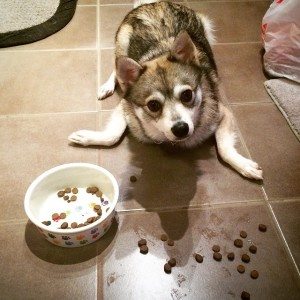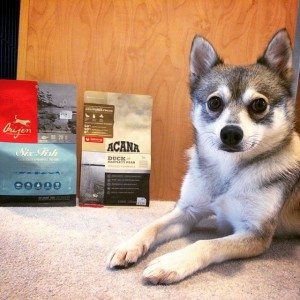What should you feed your Alaskan Klee Kai?
Alaskan Klee Kai are known to have sensitive stomachs so finding an appropriate, high quality feed for them may be tricky, especially if your pup is a picky eater like Kobi. Possible food in-tolerances and allergies may also require you to go through multiple “trial and error” phases with different kibbles before finding one that agrees with your pup. Kobi for example has an intolerance to salmon and it has taken us a little while to identify that.
Okay…so let’s go through some points that are important in finding a good, high quality kibble for your pup!
Please be weary with the dog food sold at general grocery stores.
The majority of these dog food brands offer questionable, low quality ingredients. Looking at the ingredients label, the item listed first is always the one present in the greatest amount. Corn ingredients commonly make up a large portion of low quality dog kibbles as it is a cheap form of carbohydrates; it does not offer any particular nutritional value, as it is merely filling. While meat ingredients ultimately contain the most nutritional value, they are simply not used as much in grocery dog kibble simply due to cost- they cost a lot more than things like corn.
However while meat ingredients tend to contain more nutrients compared to their corn counterparts, not all are of high quality. You may need to pay extra attention to the nutrition labeling on the bag in order to determine the exact quality of meat ingredients used. Does the ingredient list mention what type of meat? Is it chicken? Pork? Beef? Lower quality dog foods such as Purina often contain unidentifiable animal meat parts, often labeled as “meat and bone meal.” Well what exactly does that mean? That really doesn’t mean much does it? Look for specifics, high quality dog kibble brands should be proud of their meat ingredients- they should specifically say things such as “Boneless chicken,” “boneless lamb,” “beef meal,” “duck meal,” and so forth. Long story short, please pay attention to what it says on the nutritional label!
Do you have a puppy or an adult AKK?
Puppies in general require greater nutritional needs as they are actively growing, kibbles specifically for puppies may contain more calories and proteins; this may present problems for adult or older dogs as they do not require the same calorie requirements as their younger counterparts. It is therefore not recommended to feed your adult/older dog puppy kibble formulations unless specifically directed to do so by your veterinarian.
Examples of high quality dog kibbles include: Orijen, Acana, Taste of the Wild, Wilderness, Fromms (please note that this list is in no way representative of all the high quality kibbles available). We recommend that owners visit DogfoodAdvisor.com to find out more about the different high quality dog foods available.
Every dog is different.
While a certain kibble may work great for your friend’s dog, that does not necessarily mean that it will work for your pup as it is common for dogs to react differently to the same foods. As mentioned in the beginning, it may take a little bit of time and effort to find and figure out what the best food for your pup is. The best food is ultimately one that leads to proper digestion and absorption and health! Remember a sign of a healthy pup is a nice and shiny fur coat!

Eww i’m not eating this!
Always be aware of possible food in-tolerances and allergies!
Food in-tolerances and allergies can cause nonspecific symptoms such as diarrhea, gas, upset stomach or even an itchy behind. If you suspect that your pup has food in-tolerances or allergies, you may need to carefully limit his food intake in order to determine the food culprit- this may take time and that’s okay! Chicken can tend to cause problems for some pups, but that surely cannot be said for all dogs. Before the culprit is identified, you may wish to purchase small “sample-sized” bags of dog food for your pup to try- this way you can see how they tolerate it first before committing yourself to a larger 25 kg sized bag.


















